The “BERGKRISTALL” Underground Plant at St. Georgen
Fact Sheet
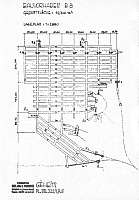
- Location: A-4222 Sankt Georgen an der Gusen, Austria
- Production Area: 50.000 m2 (bomb-proof & gas-tight)
- Slave-Workers: 10.000 Production “Bergkristall-Fertigung” (code-name: ESCHE 2)
6.500 Construction “Bergkristall-Bau” - Purpose: Me-262 jet propelled plane (fuselage assembly)
- Construction start: 9 March 1944 (foundation of KL Gusen II concentration camp)
- Concentration-Camp: KL Gusen II (most evil satellite of Mauthausen-Gusen complex)
- Number of Victims: 8.000 to 20.000 prisoners of Mauthausen-Gusen complex
- Related Monument: Memorial Crematorium KZ Gusen (40.000 victims)
- Liberation: May 1945 (S/Sgt. Al Kosiek & 23 men of 1st Platoon Troop D, 41st Cav Recon Sqdrn, 11th ArdDiv, 3rd US-Army
With more than 50.000 m2 (some 8,5 km tunnnel length) one of the biggest german underground installations that reached production status in late 1944. According to Allied intelligence reports, it was “one of the most modern and most complete underground plants in Germany”.
Slave Work by KZ Gusen II Inmates
Constructed within 13 months by prisoners of the KZ Gusen II concentration camp within the Mauthausen-Gusen complex it became one of the most horrible concentration camp sites in European history due to its high mortality of up to 98% (average survival period 4 months).
Main deportations came form KL Auschwitz-Birkenau and western Europe (France, Italy, Belgium, Luxembourg) when Nazi-troops had to move out this countries due to military pressure of the Allied Forces. A vast number of the Jewish man were exterminated by hardest labor at the tunnel construction site.
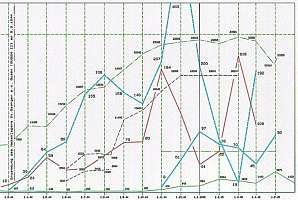
Increase of number of inmates and development of production at the Gusen complex after the foundation of KZ Gusen II (Source: Rudolf A. Haunschmied, "300 Jahre erweitertes Marktrecht St. Georgen an der Gusen, 1989")
With Winter 1944/45 more deportations came in than lives were consumed, by construction and production. So, many died in unopend railway cars at the local station, froze to death or were killed by the many other cruelties of the KZ Gusen II “extermination” camp.
One of the many not so well known victims of the KL Gusen II “BERGKRISTALL” plant had been the young french youth activist Marcel Callo. He became beatified by Pope John Paul II. in 1987.
Strategic War Production
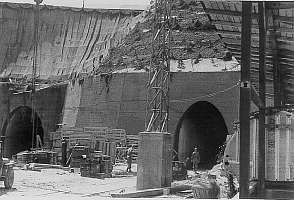
According to Allied intelligence, some 987 jet propelled planes left serial production lines. Construction of tunnel-system was nearly finished and installations operational for some 85%.
Production started in parallel to construction of the tunnel-system in Summer 1944 and reached maximum in April 1945 (some 450 jet-plane fuselages, fully equipped per month).
Original planned production capacity should have been 1.250 jet-planes per month until the year 1955.
Fuselages and wings were brought by railway cars during the night from BERGKRISTALL to several locations in southern Germany and Bohemia where the turbines had been fixed and the jets became operational.
Secrecy was extremely high: The test-pilots didn’t know where the planes came from. German civilians being employed at BERGKRISTALL were not allowed to give the name of town where they did work to any third persons.
Extermination Plans
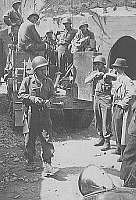
With the end of the war plans and preparations were made to blast-off this top secret installation along with the slave-workers, the local population and the other eye-witnesses to prevent knowhow-transfer to allied forces and to kill potential prosecutors for later Mauthausen-Gusen trials.
This plan was not carried out due to the unclear situation in early May 1945. Vice-major Aschenbrenner of St. Georgen/Gusen and the Swiss Red-Cross delegate Louis Haefliger played key roles in an attempt to prevent this tragedy. The installations of strategic importance were later on investigated and partly dismantled by US troops.
With August 1945 BERGKRISTALL was handed over to the Soviets. The Soviets dismantled all of the residual installations and finally destroyed the key-parts of this strategic tunnel-system in November 1947.
After this, BERGKRISTALL and KL Gusen complex became totally forgotten and never appeared in a more comrehensive way in any scientific or research thesis until GMC founding member Rudolf A. Hanschmied published a first history of the SS activities in St. Georgen/Gusen in the history book “300 Jahre erweitertes Marktrecht St. Georgen an der Gusen [300 Years Extended Market Rights of St. Georgen an der Gusen]” upon request of the Municipality of St. Georgen/Gusen in 1989.
Late Destruction
Unfortunately, this publication could not save the former underground railway tunnels in BERGKRISTALL to be destroyed in the years 1989 and 1990 with permission by Austrian mining authorities.
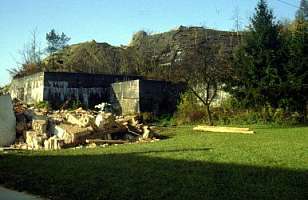
Since the BERGKRISTALL plant was built by the SS in 1944 and 1945 without any formal construction permit it was considered as a superaedificate with no proprietor for many decades after the war.
Only in 2000, the Austrian authorities decided to succeed the Third Reich as proprietor of this huge tunnel system.
Unfortunately, only two of the former 8.5 kilometers of tunnel length were left over in the first decade of the 21st century by “Bundesimmobiliengesellschaft” because decision was made to fill most of the tunnels with concrete.
The Gusen Memorial Comittee (GMC) and the Community of St. Georgen/Gusen take pains since the late 1990-ties to get the remaining tunnels of BERGKRISTALL open to the public and entered into a regional concept of memorials in the “St. Georgen-Gusen-Mauthausen Region of Awareness“.
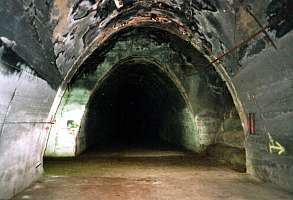
Since 2007 “Audiowalk Gusen” connects the KZ Gusen Memorial at Langenstein with todays closed gate to this huge underground plant at St. Georgen/Gusen.
Since 2010, suvivors and other interested people have access to this important underground memorial of KZ Gusen II along with the yearly local-international commemorations in May by the courtesy of the Bundesimmobiliengesellschaft (BIG) but with formal registration.
In the vicinity of BERGKRISTALL there still exist the ruins of one further, but smaller underground installation with the code-name KELLERBAU (just 12.000 m2). KELLERBAU was used to house some key production facilities for the production of machine guns for Steyr-Daimler-Puch AG.
That means; in addition to the 16.000 prisoners of BERGKRISTALL, some further 8.500 prisoners and some 4.000 prisoners had to work and die in Gusen for this small-arms plant and the stone-quarries owned by the “Deutsche Erd- und Steinwerke GmbH (DEST)”, a company of the SS that had its “Austrian” office at St. Georgen/Gusen.
Logistic Network
Between 1943 and 1945, millions of tons of material were brought from all over the Third Reich via the railway station at Sankt Georgen an der Gusen to the construction site and the underground plant of B8 BERGKRISTALL – ESCHE 2.
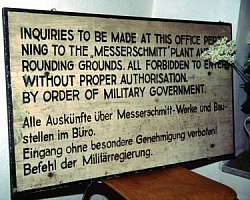
The most important locations within the B8 BERGKRISTALL-ESCHE 2 network are structured according to the subsequent classification (in alphabetical order):
- Me-262: Material going out for Messerschmitt GmbH
- Me-262: Material comming in for Messerschmitt GmbH
Me-262: Material going out for Messerschmitt GmbH to:
- ATTNANG-PUCHHEIM received “spare parts” (Ersatzteile)
- BALLENSTEDT received “spare parts” (Ersatzteile) and “empty boxes”
- BERLIN received “spare parts” (Ersatzteile)
- BERLIN-WEISSENSEE received “container boxes” (Behaelterkisten)
- BERLIN-STAAKEN received “spare parts” (Ersatzteile)
- BODENWOEHR received “spare parts” (Ersatzteile)
- BRANDENBURG received fuselages (Ruempfe)
- BUDWEIS (CESKE BUEJOVICE) received machine tools (Werkzeugmaschinen)
- BURGAU received fuselages (Ruempfe) until Oktober 1944 and “spare parts” (Ersatzteile)
- CHAM received received “spare parts” (Ersatzteile)
- DRESTEDT received “spare parts” (Ersatzteile)
- FALLERSLEBEN received “tooling” (Werkzeug) and “spare parts” (Ersatzteile) and aircraft parts (Flugzeugteile) until July 1944
- FISCHAMEND received aircraft parts (Flugzeuteile) until March 1944
- FLOSSENBUERG received “spare parts” (Ersatzteile) until October 1944 and machinery (Maschinen)
- GRASLITZ received “spare parts” (Ersatzteile)
- GUENZBURG received fuselages (Ruempfe) until the end of the war and “Rumpfwerk”
- HAGELSTADT received fuselages (Ruempfe) and “spare parts” (Ersatzteile)
- HOECHST received received “empty boxes”, “Behaelterkisten”
- JETTINGEN received “spare parts” (Ersatzteile)
- KAHLA (REIMAHG AG) received fuselages (Ruempfe)
- KEFERMARKT received aircraft parts (Flugzeugteile) until July 1944
- KUBOHUETTE (KUBOVA HUT) received “spare parts” (Ersatzteile), “Wannen” and “Wannenverschlaege”
- LUNGITZ received “spare parts” (Ersatzteile) and aircraft parts (Flugzeugteile)
- LEIPHEIM received fuselages (Ruempfe) until Dezember 1944 and “spare parts” (Ersatzteile)
- OBERNZELL received “spare parts” (Ersatzteile) and “Rumpfwerk”
- OBERTRAUBLING received “spare parts” (Ersatzteile)
- PLANKENHEIM received aircraft parts (Flugzeugteile) until June 1944
- PLETTENBERG received “antennas” (Antennen), “Verschlaege”
- REGENSBURG received fuselages (Ruempfe), “spare parts” (Ersatzteile), machinery (Maschinen) and “large furnaces” (Grossraumoefen)
- SCHWAEBISCH HALL received fuselages (Ruempfe) until Dezember 1944 and “Rumpfwerk”
- SINGEN received “aluminum scrap DEST” (Duralabfaelle DEST)
- SULZDORF received “spare parts” (Ersatzteile)
- SUNZENDORF received “boxes” (Kisten)
- VILSEK received “spare parts” (Ersatzteile) and “aircraft parts” (Flugzeugteile)
- WELS received “spare parts” (Ersatzteile)
- ZARTLESDORF received aircraft parts (Flugzeugteile) until July 1944
Me-262: Material comming in for Messerschmitt GmbH from:
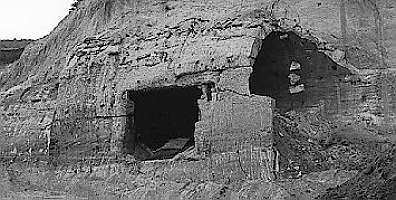
- BAYREUTH delivered work benches (Werkbaenke)
- BODENWOEHR delivered “spare parts” (Ersatzteile) until January 1945
- DACHAU delivered work benches (Werkbaenke)
- ESCHENLOHE delivered … (Wehrmachtsteile), fans (Ventilatoren) and machinery (Maschinen)
- FALLERSLEBEN delivered parts for fuselages (Rumpfteile)
- FISCHAMEND delivered machinery (Maschinen)
- FLOSSENBUERG delivered “spare parts” (Ersatzteile) until January 1945, parts for machinery (Maschinenteile) and wings (Flaechen)
- FRANZENSTHAL delivered aircraft hulls “Wannen” and “spare parts” (Ersatzteile)
- GRASLITZ delivered “spare parts” (Ersatzteile), aircraft parts (Flugzeugteile) and brass (Bleche)
- GUENZBURG delivered fixtures for shipment (Verladeboecke)
- HAGELSTADT delivered parts for machinery (Maschinenteile), machinery (Maschinen) and “spare parts” (Ersatzteile) until January 1945, water tanks (Wasserbehaelter)
- INGOLSTADT delivered “spare parts” (Ersatzteile) until Dezember 1944
- KOEFERING [KAUFERING?] delivered paint (Farbe) and “spare parts” (Ersatzteile)
- KUBOHUETTE delivered aircraft hulls “Wannen”
- LUNGITZ delivered electric material (Elektromaterial), transformer (Transformatoren), containers (Behaelter), fuel tanks (Kraftstoffbehaelter), tubes (Rohre), brass (Bleche)
- MAUTHAUSEN delivered tools (Werkzeuge), machinery (Maschinen) and brass (Bleche)
- MITTERTEICH delivered “spare parts” (Ersatzteile) and machinery (Maschinen)
- OBERNZELL delivered “spare parts” (Ersatzteile), charger (Ladegeraete), tubes (Rohre) and eccentric presses (Exzenterpressen)
- OBERTRAUBLING delivered “spare parts” (Ersatzteile), “equipment” (Geraete) and workshop equipment (Werkstatteinrichtung)
- PASSAU delivered sheets (Platten)
- PLETTENBERG delivered “aluminum” (Leichtmetall), aircraft parts (Flugzeugteile) and well protectors (Bohrgeruest)
- PRUEFENING delivered “spare parts” (Ersatzteile)
- RAMINGDORF delivered fixtures for assemlby (Montagestaender)
- REGENSBURG delivered “spare parts” (Ersatzteile), machinery (Maschinen), paint (Farbe), dislocation material (Verlagerungsgut), operating ressources (Betriebsmittel), work benches (Werkbaenke), carriages for wing assembly (Fluegelwagen)
- REGENSTAUF delivered aircraft parts (Flugzeugteile)
- SCHWANDORF delivered cast items (Gussteile) and iron components (Eisenteile)
- SULZDORF delivered aircraft parts (Flugzeugteile)
- WEILHEIM delivered “aluminum” (Leichtmetall)
- WELS delivered “spare parts” (Ersatzteile) until November 1944
- WENDLINGEN delivered “spare parts” (Ersatzteile) until January 1945
Recommended Literature
- Aldebert Bernard, Chemin de Croix en 50 Stations de Compiegne a Gusen II en passant par Buchenwald, Mauthausen e Gusen I, Fontenay-aux-Roses 1946 (see also Hoelzl, Gusen II …)
- Aldebert Bernard, Il campo di sterminio di Gusen II dall orrore della morte al dolore del ricordo, Selene Edizioni, Milano 2002
- Amicale Luxembourgois de Mauthausen, Letzeburger zu Mauthausen – Gusen II, Luxembourg 1970
- Bernadac Christian, Le Neuvieme Cercle – Gusen II, Editions France Empire, Paris 1975
- Dobosiewicz Stanislaw, Vernichtungslager Gusen, Mauthausen-Studien, Band 5, Schriftenreihe der KZ-Gedenkstaette Mauthausen, Vienna 2007
- Hanausch Reinhard, Luebbers Bernhard, Smolorz Roman, Spoerer Mark (ed.), Ueberleben durch Kunst – Zwangsarbeit im Konzentrationslager Gusen für das Messerschmittwerk Regensburg, Dr. Peter Morsbach Verlag, Regensburg 2012
- Haunschmied Rudolf A., NS-Geschichte 1938 bis 1945, 400 Jahre Markt St. Georgen an der Gusen, Marktgemeinde St.Georgen a.d. Gusen, 2011
- Haunschmied Rudolf A., Mills Jan-Ruth, Witzany-Durda Siegi, St. Georgen-Gusen-Mauthausen – Concentration Camp Mauthausen Reconsidered, Books on Demand, Norderstedt 2008
- Haunschmied Rudolf A., The Gusen II "Jew Camp" and the Messerschmitt "Bergkristall" underground plane factory in St. Georgen on the Gusen, in: Joseph Fisher, The Heavens were Walled-In, Academic Press, Vienna 2017
- Harfenes Rav Yechezkel, Slingshot of Hell, Targum Press Inc, Southfield, Michigan 1988
- Hoelzl Elisabeth, Gusen II – Leidensweg in 50 Stationen. Uebersetzt und herausgegeben nach Bernard Aldebert “GUSEN 2 – chemin de croix en 50 stations” mit einem Vorwort von Pierre Serge Choumoff, Bibliothek der Provinz, Weitra 1997 (see also Aldebert, Chemin de Croix …)
- Littner Karl, ed. Rudolf A. Haunschmied, Life Hanging on a Spider Web – From Auschwitz-Zasole to Gusen II, Books on Demand, Norderstedt 2011
- Vitry Stephanie, Les Morts de Gusen, Maitrise d´histoire, Universite de Paris I, Panteon-Sorbonne, 1994
- Zuckermann Abraham, A Voice in the Chorus: Life as a Teenager Saved by Schindler, First Longmeadow Press Edition, Stamford, CT 06904, U.S.A., 1994 (like several others of the Jews saved by Oskar Schindler, Abraham Zuckerman (founding member of the USHMM at Washington) finally was sent to KZ Gusen II where he was liberated at May 5, 1945).
#RememberGusen